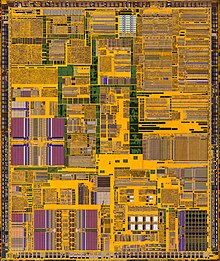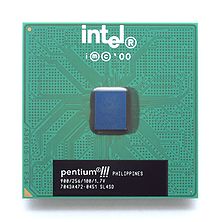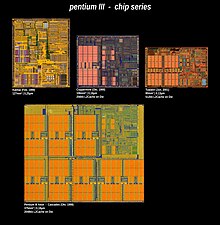Pentium III
The most notable differences were the addition of the Streaming SIMD Extensions (SSE) instruction set (to accelerate floating point and parallel calculations), and the introduction of a controversial serial number embedded in the chip during manufacturing.There have been some early models of the Pentium III with 450 and 500 MHz packaged in an older SECC cartridge intended for original equipment manufacturers (OEMs).The ATC operates at the core clock rate and has a capacity of 256 KB, twice that of the on-chip cache formerly on Mendocino Celerons.[5] Under competitive pressure from the AMD Athlon, Intel reworked the internals, finally removing some well-known pipeline stalls.FC-PGA and Slot 1 Coppermine CPUs have an exposed die, however most higher frequency SKUs starting with the 866 MHz model were also produced in FC-PGA2 variants that feature an integrated heat spreader (IHS).[7] A 1.13 GHz version (S-Spec SL4HH) was released in mid-2000 but famously recalled after a collaboration between HardOCP and Tom's Hardware[8] discovered various instabilities with the operation of the new CPU speed grade.The Coppermine core was unable to reliably reach the 1.13 GHz speed without various tweaks to the processor's microcode, effective cooling, higher voltage (1.75 V vs. 1.65 V), and specifically validated platforms.Intel used the latest FC-PGA2 Coppermines with the cD0 stepping and modified them so that they worked with low voltage system bus operation at 1.25 V AGTL as well as normal 1.5 V AGTL+ signal levels, and would auto detect differential or single-ended clocking.[14][15][16] Some motherboard manufacturers would mark the change with blue sockets (instead of white), and were often also backwards compatible with Coppermine CPUs.However, the enthusiast community found a way to run Tualatins on then-ubiquitous BX chipset based boards, although it was often a non-trivial task and required some degree of technical skills.Tualatin-based Pentium III CPUs can usually be visually distinguished from Coppermine-based processors by the metal integrated heat-spreader (IHS) fixed on top of the package.However, the last models of Coppermine Pentium IIIs also featured the IHS — the integrated heat spreader is actually what distinguishes the FC-PGA2 package from the FC-PGA — both are for Socket 370 motherboards.It was also sometimes difficult to achieve a flat mating of the CPU and heatsink surfaces, a factor of critical importance to good heat transfer.Since Katmai was built in the same 250 nm process as Pentium II "Deschutes", it had to implement Streaming SIMD Extensions (SSE) using minimal silicon.







clock rateTechnology nodeMicroarchitectureInstruction setTransistorsSlot 1Socket 370Socket 495(mobile)Socket 479CeleronPentium IIPentium 432-bitP6 microarchitectureStreaming SIMD Extensionsinstruction setfloating pointPentium MPentium M microarchitectureNetBurstCore microarchitectureCore 2Pentium Dual-CoreDesktopMobileDeschutesL1 cachealuminum interconnectoriginal equipment manufacturersstepping levelAdvanced Micro DevicesAthlonsset-associativeAthlonpipelineintegrated heat spreaderthermal pasteTom's HardwareMicro-PGA2copper interconnectsFC-PGATualatin ValleyTualatin Riverdouble-cyclingFront-side busList of Intel Pentium III processorsEuropean ParliamentIvy Bridgemodel-specific registersmachine check exceptionhardware-based random number generatorList of Intel Celeron processorsIntel CorporationDiefendorff, KeithMicroprocessor ReportNetwork ComputingIntel processorsProcessorsPentiumItaniumMicroarchitecturesChipsetsP6 variant (Pentium M)P6 variant (Enhanced Pentium M)x86-6464-bitPenrynNehalemWestmereSandy BridgeHaswellBroadwellSkylakeCannon LakeSunny CoveCypress CoveWillow CoveGolden CoveBonnellSaltwellSilvermontGoldmontGoldmont PlusTremontGracemont16-bit80C18780387SX80387DXRapidCADOverDriveA100/A110Original i586Dual-CoreP6-basedNetBurst-basedCore-basedTolapaiNehalem-basedSandy Bridge-basedIvy Bridge-basedHaswell-basedBroadwell-basedSkylake-basediAPX 432StrongARMXScaleTick–tock modelProcess–architecture–optimization modelIntel GPUsIntel HD, UHD, and Iris GraphicsStratixCodenamesLarrabee